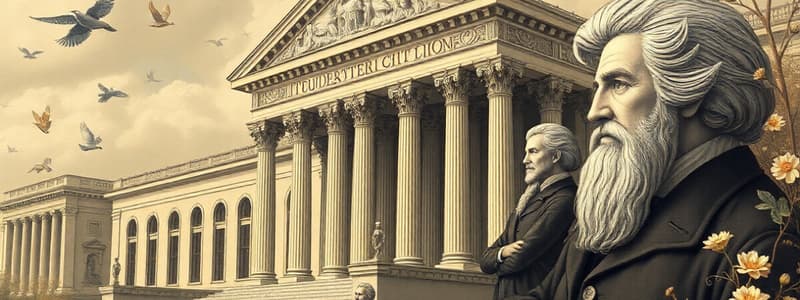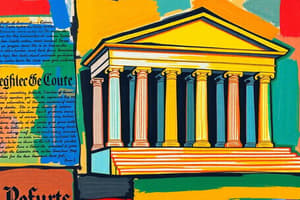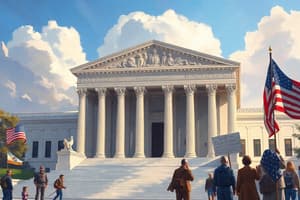Podcast
Questions and Answers
Who was the first woman ordained to preach in the United States?
Who was the first woman ordained to preach in the United States?
- Amelia Earhart
- Antonette Brown Blackwell (correct)
- Susan B. Anthony
- Harriet Beecher Stowe
Andrew Johnson was impeached and removed by the House of Representatives in 1868.
Andrew Johnson was impeached and removed by the House of Representatives in 1868.
False (B)
What were John Adams's last words before he died in 1826?
What were John Adams's last words before he died in 1826?
Thomas Jefferson survives
Charles Grandison Finney was a lawyer before he became a __________.
Charles Grandison Finney was a lawyer before he became a __________.
Match the following statements with their truth values:
Match the following statements with their truth values:
Which amendment abolished slavery?
Which amendment abolished slavery?
Sojourner Truth delivered the speech "Ain't I a Woman" in 1851.
Sojourner Truth delivered the speech "Ain't I a Woman" in 1851.
Who was a leading figure in the transcendentalist movement?
Who was a leading figure in the transcendentalist movement?
The __________ of 1845-49 caused a significant influx of immigrants from Ireland.
The __________ of 1845-49 caused a significant influx of immigrants from Ireland.
Which Supreme Court Justice wrote the decision on Marbury v. Madison (1803)?
Which Supreme Court Justice wrote the decision on Marbury v. Madison (1803)?
Match the following Supreme Court cases with their corresponding Justices:
Match the following Supreme Court cases with their corresponding Justices:
The Battle of New Orleans occurred before peace was established between England and the United States.
The Battle of New Orleans occurred before peace was established between England and the United States.
Who organized the Seneca Falls Convention and wrote the Declaration of Sentiments?
Who organized the Seneca Falls Convention and wrote the Declaration of Sentiments?
What is the best brief definition of a primary source?
What is the best brief definition of a primary source?
The Battle of Gettysburg was a turning point for the Confederate victory in the Civil War.
The Battle of Gettysburg was a turning point for the Confederate victory in the Civil War.
Which commodity was a symbol of status and wealth for the Comanche?
Which commodity was a symbol of status and wealth for the Comanche?
Harriet Beecher Stowe wrote _____.
Harriet Beecher Stowe wrote _____.
Which person enlisted as a United States soldier during the Mexican-American War?
Which person enlisted as a United States soldier during the Mexican-American War?
Mill girls, aged 15-35, who lived on-site, operated the looms in the Lowell Massachusetts textile mills.
Mill girls, aged 15-35, who lived on-site, operated the looms in the Lowell Massachusetts textile mills.
Match the following individuals with their significant contributions or actions:
Match the following individuals with their significant contributions or actions:
John Adams made the midnight appointments to protect Federalist power.
John Adams made the midnight appointments to protect Federalist power.
Which battle during the Civil War was a significant Union loss?
Which battle during the Civil War was a significant Union loss?
The Know Nothing political party emerged because of the value of nativism.
The Know Nothing political party emerged because of the value of nativism.
Who reported on lynchings in the South?
Who reported on lynchings in the South?
The group that resisted reconstruction efforts and aimed to protect white supremacy in the South was called the ______.
The group that resisted reconstruction efforts and aimed to protect white supremacy in the South was called the ______.
Which individual was NOT a candidate in the 1860 presidential election?
Which individual was NOT a candidate in the 1860 presidential election?
Match the following concepts with their descriptions:
Match the following concepts with their descriptions:
The Richmond Bread Riot was a cause of the Civil War.
The Richmond Bread Riot was a cause of the Civil War.
What best describes the notion of Reconstruction?
What best describes the notion of Reconstruction?
Flashcards
13th Amendment
13th Amendment
Abolished slavery in the United States
14th Amendment
14th Amendment
Granted citizenship and equal rights to formerly enslaved people and African Americans
15th Amendment
15th Amendment
Prohibited denying voting rights based on race, color, or previous servitude
Democratic-Republican
Democratic-Republican
Signup and view all the flashcards
Transcendentalism
Transcendentalism
Signup and view all the flashcards
Seneca Falls Convention
Seneca Falls Convention
Signup and view all the flashcards
Scot v. Sandford
Scot v. Sandford
Signup and view all the flashcards
Treaty of Guadalupe Hidalgo
Treaty of Guadalupe Hidalgo
Signup and view all the flashcards
Battle of Fredericksburg
Battle of Fredericksburg
Signup and view all the flashcards
Know Nothing Party
Know Nothing Party
Signup and view all the flashcards
Horace Greeley
Horace Greeley
Signup and view all the flashcards
Cause of Civil War (incorrect)
Cause of Civil War (incorrect)
Signup and view all the flashcards
Republican Party
Republican Party
Signup and view all the flashcards
Reconstruction
Reconstruction
Signup and view all the flashcards
Ku Klux Klan
Ku Klux Klan
Signup and view all the flashcards
Secondary Source Definition
Secondary Source Definition
Signup and view all the flashcards
Primary Source Definition
Primary Source Definition
Signup and view all the flashcards
Age of Exploration Shift
Age of Exploration Shift
Signup and view all the flashcards
Comanche Status Symbol
Comanche Status Symbol
Signup and view all the flashcards
Mexican-American War Soldier
Mexican-American War Soldier
Signup and view all the flashcards
Uncle Tom's Cabin Author
Uncle Tom's Cabin Author
Signup and view all the flashcards
Civil War Turning Point Battle
Civil War Turning Point Battle
Signup and view all the flashcards
Mexican-American War Critic
Mexican-American War Critic
Signup and view all the flashcards
Judiciary Act of 1801
Judiciary Act of 1801
Signup and view all the flashcards
Finney's Profession Before Revivalism
Finney's Profession Before Revivalism
Signup and view all the flashcards
Transcendentalist Religious Views
Transcendentalist Religious Views
Signup and view all the flashcards
Antonette Brown Blackwell's Ordination
Antonette Brown Blackwell's Ordination
Signup and view all the flashcards
Andrew Johnson's Impeachment Outcome
Andrew Johnson's Impeachment Outcome
Signup and view all the flashcards
John Adams's and Thomas Jefferson's Last Words
John Adams's and Thomas Jefferson's Last Words
Signup and view all the flashcards
Study Notes
Supreme Court Rulings
- Scot v. Stanford: Roger B. Taney wrote the decision and ruling
- Other three cases: John Marshall wrote the decisions and rulings
Amendments
- 13th Amendment: Abolished slavery
- 14th Amendment: Granted citizenship and equal rights to formerly enslaved people and African Americans.
- 15th Amendment: Prevents denial of voting rights based on race, color, or previous servitude
Supreme Court Cases
- Marbury v. Madison (1803): John Marshall wrote the decision
- War of 1812 Battles: Battle of New Orleans took place after peace between England and the USA
Political Parties
- Democratic-Republican Party: Appealed to agrarian and states' rights, represented by Thomas Jefferson and James Madison
Transcendentalist Movement
- Key figure: Ralph Waldo Emerson
Historical Figures and Events
- Antoinette Brown: Leader at the Seneca Falls Convention, witnessed women gaining the right to vote
- Sojourner Truth: Delivered the "Ain't I a Woman" speech (1851)
- War of 1812: British attack and burning of Washington, D.C. was NOT a cause of the war
Additional Historical Information
-
The Great Famine (1845-1849): Caused an influx of immigrants from Ireland
-
Charles Grandison Finney: Wrote "The New Measures"
-
Treaty of Guadalupe Hidalgo: Gained land for California
-
Seneca Falls Convention (1848): Organized by Elizabeth Cady Stanton, who wrote the Declaration of Sentiments
-
Scott v. Sandford (1857): Roger B. Taney wrote the decision
-
Civil War Battle: Battle of Fredericksburg was a significant Union loss
-
Political Party: Know Nothing Party emerged due to nativism
Notable Facts and Figures
-
1860 Presidential Election: Horace Greeley was NOT a candidate
-
Civil War Cause: The Richmond Bread Riot was not a cause of the Civil War
-
Civil War-related: Elisha Hunt Rhodes enlisted in the Union Army
-
South related: Ida B. Wells reported on lynchings in the South
-
Reconstruction period: Reuniting the North and South and rebuilding social structures after the Civil War
-
1866 Secret Group: Ku Klux Klan resisted Reconstruction and supported white supremacy
-
Definitions of History: History recovers past people's recorded memories and actions
-
Primary and Secondary Sources. Primary sources are past people's thoughts and experiences; secondary sources are written about a person, place, period or event.
Further Historical Details & Events
- Age of Exploration Shift: The Atlantic world replaced the Mediterranean world
- Commodity: Horse was a symbol of status and wealth for the Comanche
- Mexican-American War Related: Benjamin Franklin Scribner was a United States soldier
- Harriet Beecher Stowe: Uncle Tom's Cabin
- Civil War Battle: Battle of Gettysburg was a turning point for the Union's victory
- Person who did NOT publicly criticize the Mexican-American War: James K. Polk
- Midnight Appointments: John Adams pushed through the Judiciary Act of 1801 and made midnight appointments to protect Federalist power (True)
- Lowell Textile Mills: Mill girls (15-35) lived and worked on-site (True)
- Revivalism: John Williamson Nevin wrote "The Anxious Bench" to promote new revivalism measures (False)
- Charles Grandison Finney: Was a lawyer before becoming a revivalist.
Political and Social Situations
- New York Connection: Transcendentalists were NOT religiously conservative and reformed Presbyterians (False)
- Women’s Rights: Antoinette Brown Blackwell was the first woman ordained to preach in the United States (True)
- Andrew Johnson Impeachment: Andrew Johnson was NOT impeached and removed by the House of Representatives (False)
- Last Words: John Adams last words, mentioning Thomas Jefferson who died hours earlier, is true.
Timeline (Page 6):
- Dates and Events
Studying That Suits You
Use AI to generate personalized quizzes and flashcards to suit your learning preferences.




